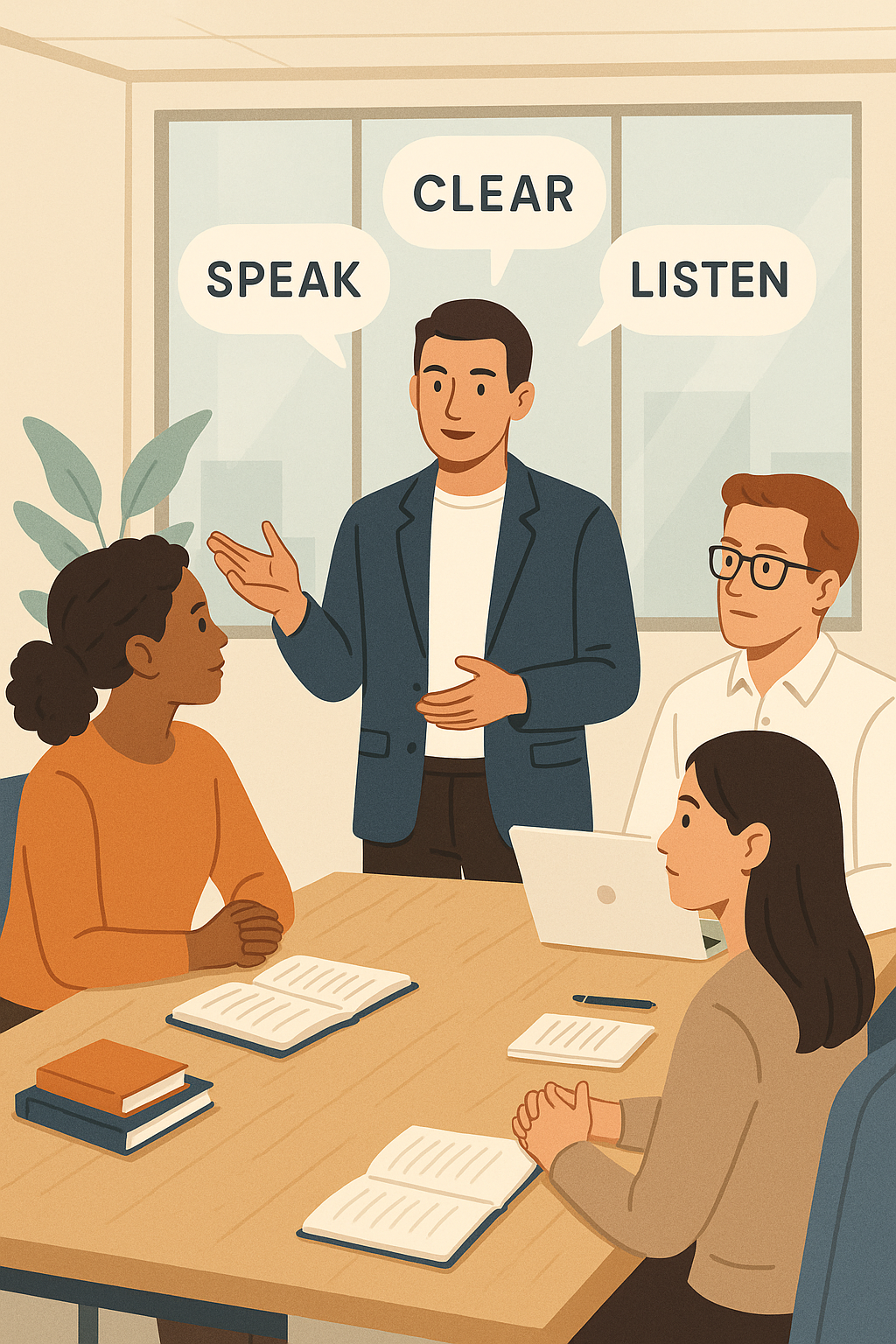Whether you’re leading a team, collaborating with colleagues, or preparing for a more senior role, your ability to express yourself clearly and connect with others can make or break your success.
Many professionals—especially those working in multicultural, global environments—struggle with communication. You might be fluent in your field’s technical language but find it difficult to explain ideas simply. Or you might be a non-native English speaker, working hard to keep up with the fast pace of meetings. Maybe you’ve been told you need to “speak up more,” but you’re unsure how to do it without feeling fake or forced.

The good news is: communication is not a fixed trait. It’s a skill you can practice, refine, and grow over time. And with the right approach, you can become not just a better communicator—but a better leader, collaborator, and teammate.
In this essay, I’ll share lessons from 20+ years in the tech industry, coaching leaders and professionals around the world. You’ll learn practical, proven ways to improve your communication skills—no jargon, no fluff, just strategies you can start using today.
Workplaces today are more connected and more complex than ever before. Remote work, global teams, and fast-changing technologies mean you’re often working with people from different countries, backgrounds, and communication styles.
Strong communication skills help you:
And here’s the truth: communication is not just about speaking well. It’s about listening, understanding, and creating connection. That’s where real leadership begins.
Before we dive into solutions, let’s look at what makes communication difficult.
In my coaching work, I hear these challenges again and again:
Do any of these sound familiar? If so, you’re not alone. The good news is, each of these challenges can be improved with practice.
Here are clear, practical steps you can take to build better communication. These tips are designed to work for both native and non-native speakers, and they apply in both everyday conversations and leadership situations.
One of the simplest and most effective ways to improve your communication is to slow down. Many people rush their words—especially in meetings where they feel nervous or want to prove themselves.
Why it works:
How to practice:
Slowing down doesn’t make you look less smart—it makes you sound more confident.
Complex words don’t make you sound more intelligent; they just create distance. The best leaders I’ve worked with can explain technical concepts in simple, everyday language.
Instead of saying:
“We must leverage cross-functional synergies to optimize operational scalability.”
Say:
“We need to work together across teams so our systems can grow smoothly.”
Tip: Pretend you’re explaining to a friend outside your industry. If they wouldn’t understand, rewrite it.
People don’t always catch your point the first time—especially in fast-moving workplaces. That’s why leaders repeat important messages in different ways.
How to do it:
Repetition isn’t annoying—it’s leadership. It makes sure your message is heard and remembered.
The best communicators aren’t just good talkers—they’re great listeners.
Active listening means:
This does two things: it shows respect, and it prevents misunderstandings. If you’re a non-native speaker, it also gives you time to process and prepare your response.
Don’t rely only on memory or spoken words. Writing things down creates clarity and alignment.
Ways to use writing for better communication:
When in doubt, put it in writing. Clear writing supports clear speaking.
One of my favorite coaching exercises: before sharing your opinion in a meeting, first summarize what others have said.
Example:
“So far I hear that we need a solution that works fast and keeps costs low. Here’s my idea…”
Benefits:
This single habit can transform how your team sees you—from quiet observer to active contributor.
Just like athletes train before a game, professionals can practice communication.
Try this:
It may feel awkward at first, but practice builds muscle memory—and confidence.
If your team speaks another language, even learning a few basic words can build bridges. A simple “hello,” “thank you,” or “well done” in someone’s native tongue goes a long way.
Why it matters:
You don’t need fluency—just curiosity and openness.
You can’t improve what you don’t measure. Ask trusted colleagues or mentors for honest feedback:
Feedback may feel uncomfortable, but it’s the fastest way to grow.
Finally, create your own “system” for communication. This could include:
A framework makes communication easier because you’re not starting from zero every time.
If you’re in (or aiming for) a leadership role, your communication sets the tone for your whole team. Here’s how leaders can lead by example:
Remember: leadership is not about having the perfect words. It’s about making sure others feel heard, understood, and included.
If you’re serious about improving, here’s a simple 30-day roadmap you can follow:
Week 1:
Week 2:
Week 3:
Week 4:
At the end of 30 days, review your progress. What feels easier? Where do you still need support? Communication is a lifelong skill—but progress happens fast when you practice consistently.
Improving your communication skills is not about becoming the loudest voice in the room. It’s about becoming a voice people trust, understand, and want to follow.
If you’re a non-native speaker, remember: your accent is not a weakness. Your perspective and effort to connect across languages are a strength.
And if you’re a leader, your responsibility is bigger than just “being clear.” It’s about creating connection, showing respect, and making sure everyone’s voice is heard.
Because in the end, communication is not performance it’s relationship.
Diamantino (Tino) Almeida is a leadership coach, writer, and technologist with over 20 years of experience helping professionals grow in their careers. He has coached leaders and engineers from companies like Google, Microsoft, McLaren, and Citrix, focusing on communication, confidence, and shared leadership.
As a non-native English speaker himself, Tino understands the real challenges of expressing ideas in a second language and building trust across cultures. His coaching blends practical tools with honest conversations, helping people step into leadership without losing their humanity.
When he’s not coaching, Tino writes essays and guides on leadership, communication, and the future of work, challenging the old command-and-control models and building a vision of leadership based on solidarity, collaboration, and respect.
Find out if MentorCruise is a good fit for you – fast, free, and no pressure.
Tell us about your goals
See how mentorship compares to other options
Preview your first month
